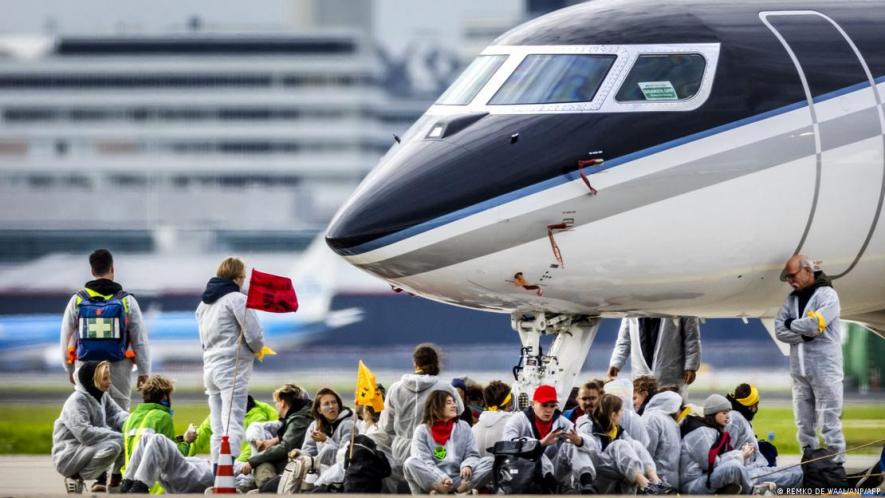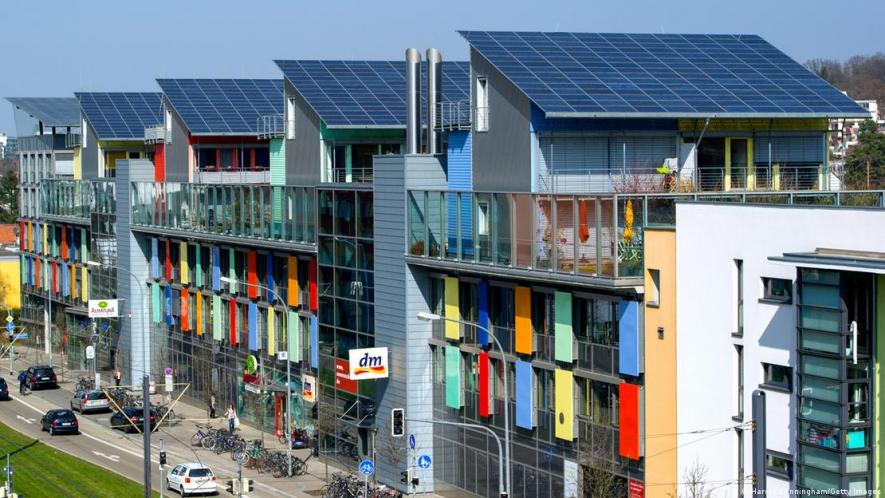How Can We Stop the Super-Rich From Polluting the Planet?

The fury came fast when makeup mogul Kylie Jenner posted a photograph last July of her and her boyfriend Travis Scott flanked by two private jets and captioned "you wanna take mine or yours?"
"Europe is on fire, meanwhile Kylie Jenner is taking 15-minute trips in her private jet," wrote eating disorder campaigner Cara Lisette in just one of the many viral tweets about Jenner's post. "I could recycle everything, buy all my clothes second hand, compost and grow my own food for the rest of my life and it wouldn't even begin to offset the footprint from one of her flights."
Jenner's Instagram post brought to the surface some of the resentment brewing among young people in rich countries who feel pressured to cut their carbon footprints. It showed the disconnect between the world's biggest polluters and a generation terrified by climate change, angry about injustice and reluctant to give up the unsustainable parts of their own lifestyles.
"This is literally why I stopped trying," wrote one 24-year-old Twitter user.

Businesswoman and reality TV star Kylie Jenner and on-again, off-again boyfriend, the rapper Travis Scott, have faced fierce criticism for flying short distances in private jets
Recently, private jets owned by celebrities like Taylor Swift and Kim Kardashian have flown distances that could have been driven in a few hours. Their journeys spewed more carbon dioxide in a matter of minutes than the average Indian emits in a year. Flight data shows that one night in early December, the private jets of Kylie Jenner and Travis Scott took the same journey, landing at Van Nuys airport in California, US, just 5 hours apart.
Even then, celebrity emissions in the air are a fraction of those at sea. Mega yachts – like Russian oligarch Roman Abramovich's 162-meter-long boat that comes with two helipads and a swimming pool — emit several times more CO2 than most mansions, planes and limousines combined. A study published in 2021 estimated that Abramovich's yacht emitted more carbon dioxide in 2018 than Tuvalu, a pacific island nation of 11,000 people.
"This is particularly sad," said Beatriz Barros, a researcher at the University of Indiana who led the study, "because the island nations are also the ones who are more at risk of consequences of climate change like rising sea levels."

Tuvalu is one of the island nations that pushed rich countries to set up a fund to pay for loss and damage from extreme weather at the COP27 climate summit
'Ridiculous' levels of carbon pollution
The biggest inequalities in carbon emissions have for decades been between rich and poor countries. Now, inequalities within countries explain more of the gap between clean and dirty lifestyles. The top 1% of global earners — somebody earning a yearly salary of about €124,000 ($132,000) — are responsible for one-fifth of the growth in carbon pollution in the last 30 years. They live in cities from Miami to Mumbai.
"The top 1% use basically a similar amount to the bottom 50% of humanity — and so obviously that, just in terms of scale, is a ridiculous proportion of the carbon budget," said Anisha Nazareth, a scientist at the Stockholm Environment Institute (SEI) studying emissions inequality.
People who fall into that top income bracket do not lead the lavish lifestyles of billionaires. But while private jets and mega yachts are on the extreme end of the scale, cruise ships and commercial passenger planes are close behind.

Hundreds of climate activists blocked an airport runway in the Netherlands in November and stopped private jets from taking off.
Flying, for instance, is one of the most polluting activities in the world. Though aviation makes up about 3% of global carbon dioxide emissions, it is the biggest source of pollution for those who fly. Experts estimate just 2-4% of the global population gets onto a plane each year.
In the same way billionaires burn more fossil fuels than almost anyone else, "there are people in the world who would rightly see us in the same relative light," said Ketan Joshi, an independent writer and consultant on clean energy, referring to middle-class people in rich countries. "You are someone's Kylie Jenner."
'Surprising support' for wealthy lifestyles
Researchers have explored ways to fix this. By raising taxes, closing legal loopholes and cracking down on tax havens, policymakers could stop the wealthiest funding the carbon-intensive excesses of their lavish lifestyles. It would also free up more money to invest in clean energy infrastructure needed to stop the planet heating.
But policies to raise taxes often face fierce opposition — even from those who would benefit from them. "In reality, we see a surprising support of the lifestyles of the very wealthy," said Stefan Gössling, a professor at Lund University in Sweden who has studied inequalities in flight emissions. People brought up in cultures that idolize the rich often oppose policies to restrict their lives.
The burden of a flight tax, for instance, would mainly hit richer people — particularly business travelers. In the EU, half the spending on air travel comes from the richest 20%. In the US and Canada, the 19% of adults who take more than four flights a year account for 79% of the flights. Some scientists and politicians have called for a frequent flier levy, where each extra flight a person takes carries a higher cost.
These inequalities mean policies to tax flights could generate vital revenue from those most able to pay. A study published in October by the International Council on Clean Transport, an environmental think tank, found that a global frequent flier levy could generate the $121 billion needed in investments each year to decarbonize aviation through 2050. Frequent fliers who take more than six flights per year — and make up just 2% of the population — would pay 81% of it.
Policymakers could also curb emissions from the very richest by banning private jets that run on kerosene. Such a ban would hit only a small percentage of flights but could push billionaires with cash to spare to invest in clean technologies that are needed for greener ways of flying. Experts say early investments like this would help advance sustainable aviation fuels and electric flights for everybody, scaling them up sooner and bringing costs down faster.
Researchers also stress that the top 1% of earners — and even the top 10% making €37,200 a year — should not limit climate action to what they purchase.

Studies have shown that putting solar panels on rooftops encourages neighbors to do the same
A study published in the journal "Nature" in 2021 found rich people have a major role in slowing climate change as consumers, investors, role models, organizational participants and citizens. That could mean taking savings out of banks that lend to fossil fuel companies, campaigning for public transport at a local council meeting, or pressuring their company management to replace business flights with virtual meetings.
"If these people in the top tier of society, measured in income and influence, actively went for this, we would see changes happening much quicker than what we see today," said Kristian Nielsen, a climate scientist and lead author of the study. "This is not available to the average person."
But it also works the other way. Some of the world's richest people and companies have poured money into lobbying against policies that threaten fossil fuels. For the richest, said Nazareth from SEI, "a bigger problem is really the way they exert political influence through campaign donations — and influence in general on the lifestyles of everybody else."
Edited by: Jennifer Collins
Get the latest reports & analysis with people's perspective on Protests, movements & deep analytical videos, discussions of the current affairs in your Telegram app. Subscribe to NewsClick's Telegram channel & get Real-Time updates on stories, as they get published on our website.
























